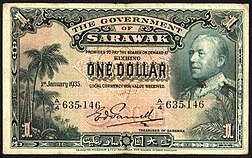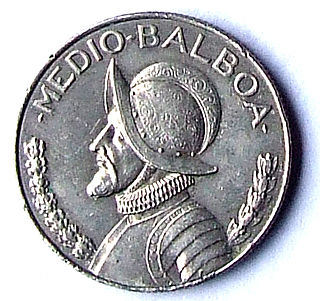
The balboa is, along with the United States dollar, one of the official currencies of Panama. It is named in honor of the Spanish explorer/conquistador Vasco Núñez de Balboa. The balboa is subdivided into 100 centésimos.

The Brunei dollar, has been the currency of the Sultanate of Brunei since 1967. It is normally abbreviated with the dollar sign $, or alternatively B$ to distinguish it from other dollar-denominated currencies. It is divided into 100 sen (Malay) or cents (English). The Brunei dollar is issued by the Brunei Darussalam Central Bank.

The franc, also commonly distinguished as the French franc (FF), was a currency of France. Between 1360 and 1641, it was the name of coins worth 1 livre tournois and it remained in common parlance as a term for this amount of money. It was reintroduced in 1795. After two centuries of inflation, it was redenominated in 1960, with each new franc (NF) being worth 100 old francs. The NF designation was continued for a few years before the currency returned to being simply the franc. Many French residents, though, continued to quote prices of especially expensive items in terms of the old franc, up to and even after the introduction of the euro in 2002. The French franc was a commonly held international reserve currency of reference in the 19th and 20th centuries. Between 1998 and 2002, the conversion of francs to euros was carried out at a rate of 6.55957 francs to 1 euro.
The Singapore dollar is the official currency of the Republic of Singapore. It is divided into 100 cents. It is normally abbreviated with the dollar sign $, or S$ to distinguish it from other dollar-denominated currencies. The Monetary Authority of Singapore (MAS) issues the banknotes and coins of the Singapore dollar.
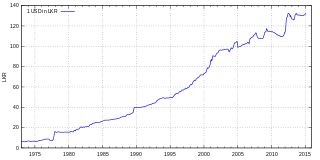
The Sri Lankan Rupee is the currency of Sri Lanka. It is subdivided into 100 cents (සත), but cents are rarely seen in circulation due to its low value. It is issued by the Central Bank of Sri Lanka. The abbreviation Re (singular) and Rs (plural) is generally used, the World Bank suggests SL Rs as a fully disambiguating abbreviation for distinction from other currencies named "rupee".
The Colombian peso is the currency of Colombia. Its ISO 4217 code is COP. The official peso symbol is $, with Col$. also being used to distinguish it from other peso- and dollar-denominated currencies.

The Belgian franc was the currency of the Kingdom of Belgium from 1832 until 2002 when the Euro was introduced. It was subdivided into 100 subunits, each known as a centiem in Dutch, centime in French or a Centime in German.

The rupia was the currency of Portuguese India sometime after 1668 until 1958. Prior to 1668, the currency unit was Xerafim. In 1666, the Portuguese administration struck a silver coin calling it double xerafin and this was declared equal to a rupia in circulation in India outside of Portuguese possessions. A xerafim was a convertible subunit of rupia, and it was unique to Portuguese colonies in India. One rupia equalled two xerafims.

The rigsdaler was the name of several currencies used in Denmark until 1875. The similarly named Reichsthaler, riksdaler and rijksdaalder were used in Germany and Austria-Hungary, Sweden and the Netherlands, respectively. These currencies were often anglicized as rix-dollar or rixdollar.
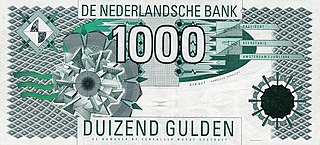
The guilder or florin was the currency of the Netherlands from 1434 until 2002, when it was replaced by the euro.

The Rupie was the currency of German East Africa between 1890 and 1916, continuing to circulate in the Tanganyika Territory until 1920.
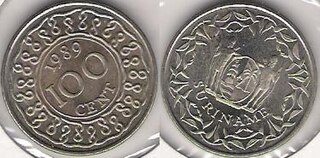
The guilder was the currency of Suriname until 2004, when it was replaced by the Surinamese dollar. It was divided into 100 cents. Until the 1940s, the plural in Dutch was cents, with centen appearing on some early paper money, but after the 1940s the Dutch plural became cent.
The Malayan dollar was the currency of the British colonies and protectorates in Malaya and Brunei until 1953. It was introduced in 1939, replacing the Straits dollar at par, with 1 dollar = two shillings four pence sterling.
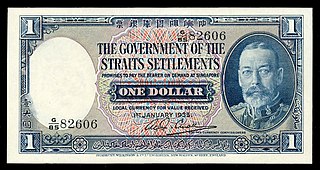
The Straits dollar was the currency of the Straits Settlements from 1898 until 1939. At the same time, it was also used in the Federated Malay States, the Unfederated Malay States, Kingdom of Sarawak, Brunei, and British North Borneo.
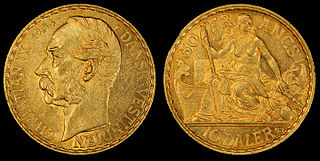
The daler was the currency of the Danish West Indies between 1849 and 1917, and of the United States Virgin Islands between 1917 and 1934.

The Malaya and British Borneo dollar was the currency of Malaya, Singapore, Sarawak, North Borneo, Brunei and the Riau archipelago from 1953 to 1967 and was the successor of the Malayan dollar and Sarawak dollar, replacing them at par. The currency was issued by the Board of Commissioners of Currency, Malaya and British Borneo. Prior to 1952, the board was known as the Board of Commissioners of Currency, Malaya.
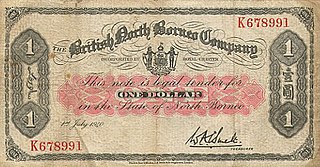
The British North Borneo dollar was the currency of British North Borneo from 1882 to 1953. It was subdivided into 100 cents. The dollar had remained at par with the Straits dollar, the currency of Malaya and Singapore, at the value of one dollar to 2 shillings 4 pence sterling from its introduction until both currencies were replaced by the Malaya and British Borneo dollar in 1953. Both coins and banknotes were issued by the British North Borneo Company.

The Japanese government-issued dollar was a form of currency issued for use within the Imperial Japan-occupied territories of Singapore, Malaya, North Borneo, Sarawak and Brunei between 1942 and 1945. The currency was also referred to informally as banana money, named as such because of the motifs of banana trees on 10 dollar banknotes. The Japanese dollar was in widespread use within the occupied territories where the previous currency became scarce. The currency were referred to as "dollars" and "cents" like its predecessors, the Straits dollar, Malayan dollar, Sarawak dollar and British North Borneo dollar.

The rigsdaler specie was a unit of silver currency used in Norway from 1544, renamed as the speciedaler in 1816 and used until 1873. Norway used a common reichsthaler currency system shared with Denmark, Hamburg and Schleswig-Holstein until 1873 when the gold standard was implemented in Scandinavia and the German Empire.

The first official currency of Brazil was the real, with the symbol Rs$. As the currency of the Portuguese empire, it was in use in Brazil from the earliest days of the colonial period, and remained in use until 1942, when it was replaced by the cruzeiro.
